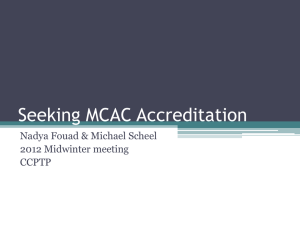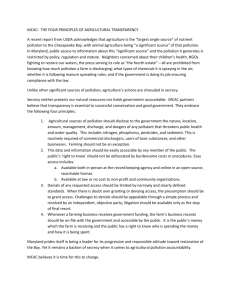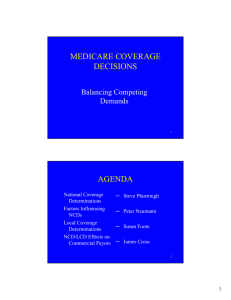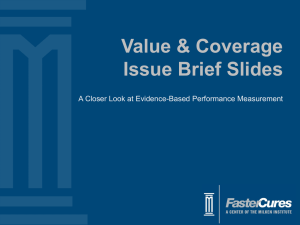Overview
advertisement
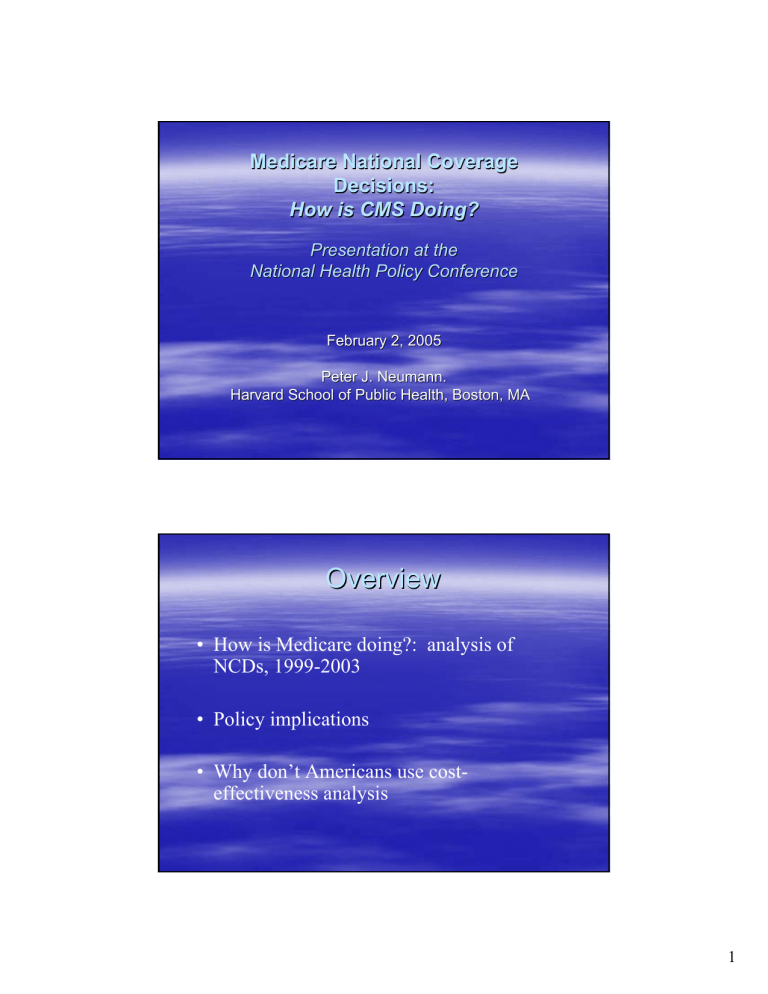
Medicare National Coverage Decisions: How is CMS Doing? Presentation at the National Health Policy Conference February 2, 2005 Peter J. Neumann. Harvard School of Public Health, Boston, MA Overview • How is Medicare doing?: analysis of NCDs, 1999-2003 • Policy implications • Why don’t Americans use costeffectiveness analysis 1 Key Dates for Medicare Coverage 1965 Medicare established (“reasonable and necessary” criteria) 1989 Proposed coverage reg with CEA 1998 MCAC created ‘99-’03 CMS notices on cov’g process 2003 Medicare Modernization Act Recent Examples of NCDs DrugDrug-eluting coronary stents ($2($2-4 billion) ICD for sudden death prophylaxis ($1($1-3 billion) PET for Alzheimer’s disease ($1 billion) Verteporfin for macular degeneration ($750 million) LeftLeft-ventricular assist devices ($1($1-7 billion) 2 Number of National Decisions Medicare National Coverage Decisions, 1999-2003 (n=69) 30 25 20 Post Aug 2003 15 Pre Aug 2003 10 5 0 1999 2000 2001 2002 2003* Year * Only complete decisions memoranda available on the CMS website prior to August 2003 were considered for the study Definition of Evidence Classification Good Evidence includes consistent results from well-designed studies Fair Evidence sufficient to determine effect on health outcomes Strength of evidence is limited Poor Evidence is insufficient to assess the effects on health outcome Strength of evidence is very limited Source: Adapted from USPSTF. 3 Quality of Evidence (CMS view) n=69 42% 45% Number of Decisions 40% 33% 35% 30% 25% 20% 16% 15% 9% 10% 5% 0% Good Fair Poor Could not be Determined Direction of Decision By Quality of Evidence Number of Decisions 40 Completely Covered 30 Covered with Conditions 20 Local Contractor Discretion 10 0 Good Fair Quality of Evidence Poor No National Coverage* *Includes decisions not to expand coverage of currently covered technologies (n=15) and not to cover the technology (n=5). (Technologies with good evidence more likely to be covered vs those with fair or poor evidence, RR=1.46, p=0.004) Source: Neumann et al., Health Affairs, 2005. 4 CMS review times by MCAC involvement MCAC Involvement Review times Overall (n=69) 8.9 months No-MCAC (n=54) 7.1 months MCAC (n=15) 14.9 months* * p<0.0001 Note: Review time from CMS acceptance of request to data final decision memo posted. Time to Decision by MCAC Participation and HTA Proportion with no Decision 1. 00 0. 75 0. 50 MCAC and HTA Neither MCAC nor HTA MCAC or HTA 0. 25 0. 00 0 100 200 300 400 500 Time (days) 600 700 800 900 Log Rank (p=0.001) 5 Time to Decision by MCAC Participation and Quality of Evidence Proportion with no Decision 1. 00 0. 75 MCAC (Fair or Poor Evidence) No MCAC (Fair or Poor Evidence) 0. 50 0. 25 No MCAC (Good Evidence) 0. 00 0 100 200 300 400 500 600 Time (days) 700 800 900 Log Rank (p=0.0033) Key Findings 1. 2. 3. 4. 5. 6. Medicare NCDs are more transparent. Decisions are consistent with evidence. Quality of evidence available is often poor. Medicare seeks to cover with conditions. CMS often does not meet time frames MCAC and HTA add to review times. 6 Policy Implications Need for better evidence – Pragmatic clinical trials – Section 1013 of MMA – Better coordination among CMS, FDA, NIH Formal criteria for coverage More resources for CMS? Innovative coverage options Include role for cost-effectiveness analysis Selected cost-effectiveness ratios for technologies covered by CMS – LeftLeft-ventricular assist devices: $500,000$500,000-$1.4 million/QALY – LungLung-volume reduction surgery: $98,000$98,000$330,000/QALY – Implantable cardioverter defibrillators: $30,000$30,000$85,000/QALY – PET for Alzheimer’s disease (> $500,000/QALY) Source: Matchar, 2003; Gillick, 2004 7 Why don’t Americans use CEA? Mistrust of methods – Methods vary – Studies not relevant Mistrust of motives Legal and regulatory barriers Distaste for (explicit) rationing We ARE using CEA, just quietly Thank you! www.hsph.harvard.edu/cearegistry 8
